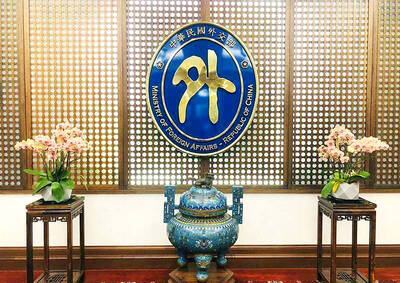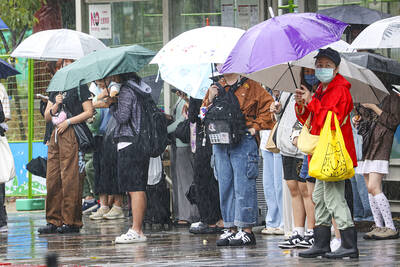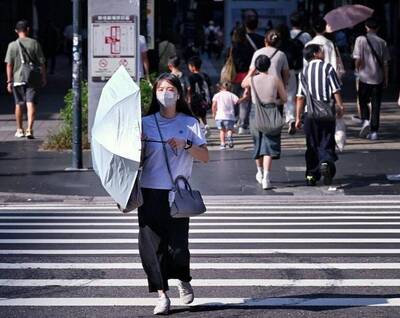Economist Scott Rozelle of Stanford University was at Taipei American School yesterday, where he gave a presentation on economic development in China.
Rozelle, who studied Chinese in Taiwan in the mid-1970s, is adjunct professor at six universities in China and heads Stanford’s Rural Education Action Project there. In 2007, he won the inaugural Chinese Academy of Science Collaboration Award for Science Research and last year received the Friendship Award from Chinese Premier Wen Jiabao (溫家寶).
There is no doubt, Rozelle said, that China has undergone an economic miracle, which finds many parallels in the miracles seen in Taiwan, South Korea and Japan a few decades ago.
From 1978 until 2004, the size of China’s economy grew 10 times, a feat that took the US 100 years to accomplish. Of the 200 million people worldwide pulled out of poverty in the past two decades, most were in China, he said.
The key component to that growth was not government anti-poverty programs — which Rozelle said had barely had an impact — but migration from rural areas to the cities. In 1980, Rozelle said, only 4 percent of Chinese workers had full-time work outside a farm; by 2007, more than 90 percent of households had at least one family member working off a farm.
Mei Xiaoyuan, a young Chinese interviewed by Rozelle, highlighted the challenges and opportunities faced by migrant workers. Mei, who left her rural home a few years ago, works at a factory owned by a South Korean firm in a Shanghai suburb. Working between 12 and 14 hours a day, 29 days a month, Mei makes NT$100 a day.
While complaining about lice and substandard living conditions, Mei said she would never go back home — an answer that contrasts with what migrant workers would have said 10 or 15 years ago, when they would move to the cities for a few years before returning home.
Mei can now send money back home and even buy cosmetics for herself.
However, while migration drives wages and increases people’s purchasing power, “demography is destiny,” Rozelle said, adding that in 1990, 20 million babies were born in China, a number that would drop to 6.5 million this year. Twelve to 15 years from now, there will be no population growth in China, he said. Demand will rise, supply will drop, causing an increase in wages.
To sustain this, China will need to ascend the production ladder to standards seen today in countries like Taiwan and South Korea, Rozelle said.
China has the entrepreneurs and the money to make this happen, Rozelle said, but it remains critically weak in one respect — education. While in Taiwan, South Korea and Japan education from kindergarten to grade 12 was almost universal by 1978, in China today, less than 2 percent of Chinese in rural areas receive higher education and only 8 percent of junior high graduates go to senior high.
Education at a rural high school costs US$160 a year, which, in US terms, is the equivalent of sending a child to an Ivy League university. Adjusted for purchasing power, putting a child in high school represents decades of work for an ordinary worker in rural China, he said.
For those who cannot afford it, migratory schools — private and unsupervised by the government — are available, but conditions there are deplorable, Rozelle said.
Besides the poor quality of education at schools in rural areas, 26 percent of students have anemia or intestinal parasites (40 percent in Gansu), with serious implications for performance, development and cognitive abilities: A survey of 600 children aged four showed that while 6 percent of children in urban areas were deemed “unprepared” for school (about 10 percent in the US), that figure was 65 percent in rural areas. All start behind, many never catch up, Rozelle said.
Asked by the Taipei Times whether a strong, centralized Chinese Community Party (CCP) would hinder or be key to success in addressing the education challenge, Rozelle said that based on his observations, the CCP appeared to be moving away from the liberalization that, in his view, will be necessary to keep China competitive in the industrial sector.

Temperatures in northern Taiwan are forecast to reach as high as 30°C today, as an ongoing northeasterly seasonal wind system weakens, the Central Weather Administration (CWA) said. CWA forecaster Tseng Chao-cheng (曾昭誠) said yesterday that with the seasonal wind system weakening, warmer easterly winds would boost the temperature today. Daytime temperatures in northern Taiwan and Yilan County are expected to range from 28°C to 30°C today, up about 3°C from yesterday, Tseng said. According to the CWA, temperature highs in central and southern Taiwan could stay stable. However, the weather is expected to turn cooler starting tonight as the northeasterly wind system strengthens again

The Ministry of Foreign Affairs (MOFA) yesterday expressed “grave concerns” after Singaporean Prime Minister Lawrence Wong (黃循財) reiterated the city-state’s opposition to “Taiwanese independence” during a meeting with Chinese Premier Li Qiang (李強). In Singapore on Saturday, Wong and Li discussed cross-strait developments, the Singaporean Ministry of Foreign Affairs said in a statement. “Prime Minister Wong reiterated that Singapore has a clear and consistent ‘one China’ policy and is opposed to Taiwan independence,” it said. MOFA responded that it is an objective fact and a common understanding shared by many that the Republic of China (ROC) is an independent, sovereign nation, with world-leading

COOLING OFF: Temperatures are expected to fall to lows of about 20°C on Sunday and possibly 18°C to 19°C next week, following a wave of northeasterly winds on Friday The Central Weather Administration (CWA) on Sunday forecast more rain and cooler temperatures for northern Taiwan this week, with the mercury dropping to lows of 18°C, as another wave of northeasterly winds sweeps across the country. The current northeasterly winds would continue to affect Taiwan through today, with precipitation peaking today, bringing increased rainfall to windward areas, CWA forecaster Liu Pei-teng (劉沛滕) said. The weather system would weaken slightly tomorrow before another, stronger wave arrives on Friday, lasting into next week, Liu said. From yesterday to today, northern Taiwan can expect cool, wet weather, with lows of 22°C to 23°C in most areas,

Taiwan sweltered through its hottest October on record, the Central Weather Administration (CWA) said yesterday, the latest in a string of global temperature records. The main island endured its highest average temperature since 1950, CWA forecaster Liu Pei-teng said. Temperatures the world over have soared in recent years as human-induced climate change contributes to ever more erratic weather patterns. Taiwan’s average temperature was 27.381°C as of Thursday, Liu said. Liu said the average could slip 0.1°C by the end of yesterday, but it would still be higher than the previous record of 27.009°C in 2016. "The temperature only started lowering around Oct. 18 or 19